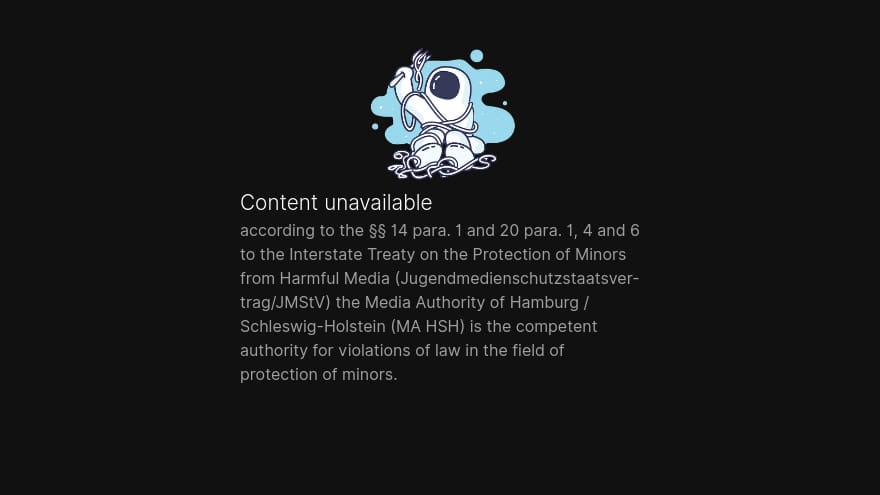Germany’s regulatory environment around online content is known for its rigorous standards. Under the Jugendmedienschutzstaatsvertrag (JMStV), the MA HSH (Media Authority of Hamburg / Schleswig-Holstein) can restrict or remove digital content deemed harmful to minors. In our current journey through these Digital Borderlands, we encounter the visible footprint of these rules: domains get blocked, streams on Odysee are censored or marked “Content unavailable,” and third parties—often ISPs—implement or enact these restrictions.
Yet the question remains: Who decides whether a piece of content is truly violating any law?
Often it’s not just the government or a single authority, but also private entities, “community watch” programs, and international data sharing flags from large telcos or domain registrars. The interplay between government regulations and private companies’ terms of service creates layers of oversight, sometimes leading to false positives or outdated data. Sections of the net become a kind of “no man’s land,” cut off from curious travelers and unsuspecting digital nomads.
The Chinese social credit system is often criticized because it is a clear, centralized, and state-driven example of surveillance and control. However, similar practices exist in Western countries, often in more subtle and decentralized forms. The key difference lies in how these systems are framed and perceived: China's system is openly authoritarian, while Western systems are often disguised as tools for security, convenience, or market efficiency.
The Telco Tangle: Domain Ownership and False Flags
Further complicating these layered restrictions is the phenomenon of “false negatives” (or false positives) in data that large telcos such as Telstra collect and share among themselves. As highlighted in recent discussions on the domain censorship issue, stale data from these big players can label entire domains or subdomains as “malicious.” This designation, in turn, leads to restrictions that may persist, even without current or concrete evidence of a threat or legal concern.
- Old Data, New Problems – When old risk assessments go uncorrected, legitimate domains get swept into a black hole of blocked IPs, leaving domain owners in an endless loop of appeals and self-verification.
- Role of ISPs – ISPs become gatekeepers, not only facilitating internet connectivity but also policing content, often behind the scenes.
In this sense, the Digital Borderlands are shaped not just by official laws but also by an opaque network of private or semi-private intermediaries who can impose or lift blocks at will.
"In Wagner's "Valkyrie," the clash between power and freedom mirrors the struggle against censorship. Just as Brünnhilde defies authority for justice, we must challenge censorship to uphold truth and individual expression. The Valkyrie problem highlights the cost of silencing voices - a reminder that only by confronting censorship head-on can we preserve the essence of our humanity and ensure a future where freedom reigns supreme." ~ Chapter: The Liberation of Data
We love how you scroll!
Community Notes and the Rise of Self-Censorship
Meanwhile, social media platforms—having received criticism for overstepping with automated censorship—are exploring new experiments in “community-driven” moderation. X (formerly Twitter) has begun introducing “community notes,” a feature intended to empower users to add context to tweets. This user feedback mechanism can reduce misinformation on certain hot-button topics, but it also raises questions:
- Echo Chambers or Community? – Could user-driven moderation simply reinforce existing biases? If a community widely believes misinformation, they might label truth as false.
- Human-Bots and the Avatars Among Us – The proliferation of bots and AI-driven avatars means that it’s often unclear whether the “community” is really human or algorithmic. These “pseudo-human” interactions may shape the digital narrative.
- Shift in Platform Identity – X is rumored to be removing blue badges and shifting identity verification, further blending lines between real human accounts and elaborate AI or bot accounts.
Here, we see a self-censoring ecosystem emerging—a feedback loop in which user communities, spurred by algorithmic prompts, collectively decide “acceptable” content. With few centralized checks, content moderation remains a never-ending quest to balance free expression and protection against harmful material.
Platforms with strong government relationships, like Yo*Tube, are often given more leeway or are seen as partners in enforcing regulations. Smaller platforms like Odysee are more likely to be treated as adversaries.
Still scrolling?
Verifying Avatars in the Borderlands Digital Wasteland
In these Digital Borderlands, user identities are as fluid as water. Avatars can be anything from a realistic selfie to a mythic creature conjured by AI. Determining the reality behind an avatar has become a core challenge:
- Age and Authorship: For legal compliance, platforms often require proof of age, but digital forms of ID can be spoofed. AI face-generation tools add more layers of obfuscation.
- Bot or Human? Behavioral analytics—typing speed, time spent on a page, style of text generation—are some signals used to identify bots, but it’s an arms race. Bots learn what denotes “human,” and adapt their patterns in turn.
- Central In-Game AI Control: In a scenario reminiscent of MMORPGs, a central AI can observe user actions, enforce content rules, and even dole out “strikes” or punishments. This might promote safer interactions, but also centralizes power in AI’s hands.
As these forces converge, the question becomes: How do we preserve trust in such a fluid world? Digital border guards, so to speak, see all travelers—a mix of humans, AI, bots, minors, and malicious actors. The answer lies in new forms of identity validation, though which ones will dominate remains unanswered.

Still scrolling?
Were the Mac is that Apple? Phoning home?
Bluesky and Mastodon: Charting a Path Through New Social Platforms
When navigating these Borderlands, weary travelers often search for safe harbors or at least alternative communication routes. Two emerging (or re-emerging) platforms are Bluesky (bsky.social) and Mastodon, serving as an example. Both aim to provide less centralized social experiences:
- Bluesky (bsky.social)
• Born out of a decentralized vision originally championed by Twitter (X) co-founder Jack Dorsey.
• Seeks to build a protocol-based environment, allowing different communities (and even separate front-ends) to talk to each other.
• Early adoption has led to a small but devoted user base, testing how less centralized moderation might work in practice. - Mastodon (joinmastodon.org)
• Federated social platform where each “instance” (server) sets its own culture, guidelines, and moderation.
• Users can roam across federated instances, but it’s easier to find your own echo chamber if you stick to a single server.
• Some find Mastodon’s decentralized approach empowering—others find it disjointed without a unifying identity or moderation standard.
Together, these platforms provide alternative routes through the Digital Borderlands. They don’t solve all of the censorship or identity problems, but they do give individuals more choice in how and where they engage.
"In the echoes of Wagner's Valkyrie, the call for freedom resonates in the realm of social media. Just as Siegmund fights for his identity, we must strive to reclaim control of our digital selves by migrating data to open-source platforms like Bluesky and Mastodon. By taking the necessary steps to empower ourselves with transparency and autonomy, we can forge a future where our online presence truly reflects our values and aspirations." ~ Chapter: The Liberation of Data
We love how you scroll!
Critiquing the Implications of the “Save Act”
Before we close, we must address the looming specter of legislations—like the “Save Act,” discussed by certain advocacy groups—that can disrupt or limit speech under the guise of “protecting” public interests. As per many critics, such Acts can potentially:
- Broaden the definition of “harmful” content, sweeping up harmless posts in the name of security.
- Increase data logs and user tracking, centralizing that power into the hands of ISPs or governments.
- Create a chilling effect for smaller platforms that can’t keep up with compliance costs, effectively silencing minority or niche voices in digital spaces.
When traveling these digital highways—through Germany’s JMStV regulations, through Big Telco restrictions, and new social frontiers like Bluesky or Mastodon—a repeated theme emerges: Censorship and platform policies are no longer singular. They’re multi-layered frameworks designed by governments, corporations, community groups, and AI systems. Each layer claims a piece of your identity, your data, or your content rights.

Truth in identity—and in content—becomes the prize we’re all chasing.
Our venture through the Digital Borderlands reveals an ever-morphing ecosystem of rules, watchers, and technologies:
- Germany’s approach to online content: Sets strict boundaries, enforced by authorities like the MA HSH and supported by ISP compliance.
- False flags and outdated security data: Lead to domain censorship that can persist beyond the original reason for restriction.
- Social platforms and “community” moderation: Platforms are shifting to community-driven moderation, but questions remain about how genuinely community-led these systems are, especially with the influence of AI-driven bot populations.
- Identity in the Borderlands: Remains elusive, with avatars, deepfakes, and central AI systems competing to define what is real.
- Alternative social networks: Platforms like Bluesky and Mastodon offer different moderation structures, each with unique promises and challenges.
- Legislations like the “Save Act”: Highlight how well-intended laws can quickly evolve into tools for broad censorship and control.
In the Digital Borderlands, where each traveler navigates an always-shifting map of restricted sites and hidden staging areas, the lines between “freedom” and “filter” are easily blurred. Truth in identity—and in content—becomes the prize we’re all chasing.

For now, what’s clear is the importance of awareness, collaboration, and, in some cases, resistance. These are the tools to help us see beyond the Mac patch, or the “Content unavailable” notice, to the deeper story that no single entity can fully silence.

DR SPACEQUIRE NOW with JOHNNY MAGRITT(e) APPLESEED.PRO and the band:
Determine Your Course
If you require additional assistance feel free to reach out to our intelligence departments via booking a consultation herein. For a comprehensive analysis or to introduce yourself in a unique way. However, time is of the essence, and the effectiveness of this action remains uncertain. Act swiftly to address your IT needs! 🚀 #ITSolutions #TechSupport #InnovationInProgress #johhnyappleseedpro

